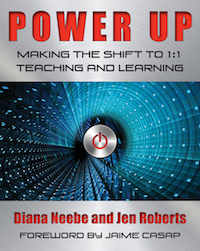How to Power Up to 1:1 Teaching & Learning
Power Up: Making the Shift to 1:1 Teaching and Learning
By Diana Neebe and Jen Roberts
(Stenhouse Publishers, 2015 – Learn more)
Any time a major shift happens in our world or the world of education, it can be downright scary. Neeble and Roberts have done a lot of the exploring in the world of technology in the classroom and provide a map to guide teachers of all disciplines to a classroom of 1:1 technology.
I have had some practice using technology in my classroom, but as I moved towards a 1:1 model, I knew I needed more information, ideas, and practice. This book is extremely helpful in giving ideas, showing possible problems, offering solutions, and brainstorming.
Resources to Enrich, Extend, and Transform

The book moves in a flow that is easy to understand and work with. While I sat down and read the entire book and then went into my lesson plans, I could easily see it used as a guide throughout the year as teachers and students get comfortable with the technology they are using.
Teacher and Student Perspectives
One of my favorite parts of the book was the real examples. There are sections where one of the authors is either observing a teacher’s use of education or talking about their own. They talk about potential problems, brainstorm solutions, show how their teaching has changed, and sometimes how it hasn’t! The reader also gets to hear a student perspective on the use of technology.
The book mentions specific apps, websites, and other tech ideas to try. First, ideas are mentioned with how they are used in a classroom, then they are listed in a table showing pros and cons, and finally there is a brainstorm of ways they could be used in different disciplines. This could be a great tool to work with colleagues across disciplines. It was nice to be able to hook up with my colleague in the art department and share ideas that could directly relate and help with her curriculum.
Because I had started experimenting with technology in the classroom before reading this book, there were some ideas that were not new to me. However, there were great ideas for how and why these technologies work, as well as extending things in new ways.
Power Up has a richly resourced
companion website
Finding a Real Audience
I especially loved the Extend section. It focused on how we as teachers can use technology to make our students’ learning more authentic and useful. Technology opens so many doors for a real audience, many of which I knew about but needed the push and ideas to see how to use them in a classroom (e.g., a blog or goodreads.com). There are also chapters in this section of differentiation and feedback/assessment. These are currently huge topics of conversation in our district, and the technology and strategies mentioned allowed me to try new things to bring ideas and feedback to our district as a whole.
I especially like using Google forms as formative assessment that guides the learning, such as asking students what they think they need to review. The Google form can automatically group kids, and teachers easily have groups that are working towards a goal they find meaningful and useful. Teachers can also use Google to provide multiple versions of a document that can lessen the planning time and work for these different group conversations or reviews. What a win!
This book is great for teachers who have been using technology for a while or are just getting started with 1:1. While it doesn’t teach technology step-by-step, it is a great guide for furthering your use of technology or finding new ways to incorporate it successfully in your class. Overall, a great and useful read!
Emily Prissel is a 7th grade English teacher in Wisconsin. She has been teaching for four years in middle school, with two years in high school English and history before. Currently, she is serving on both school-wide and district-wide committees focused on grading and assessment at the secondary level.



































